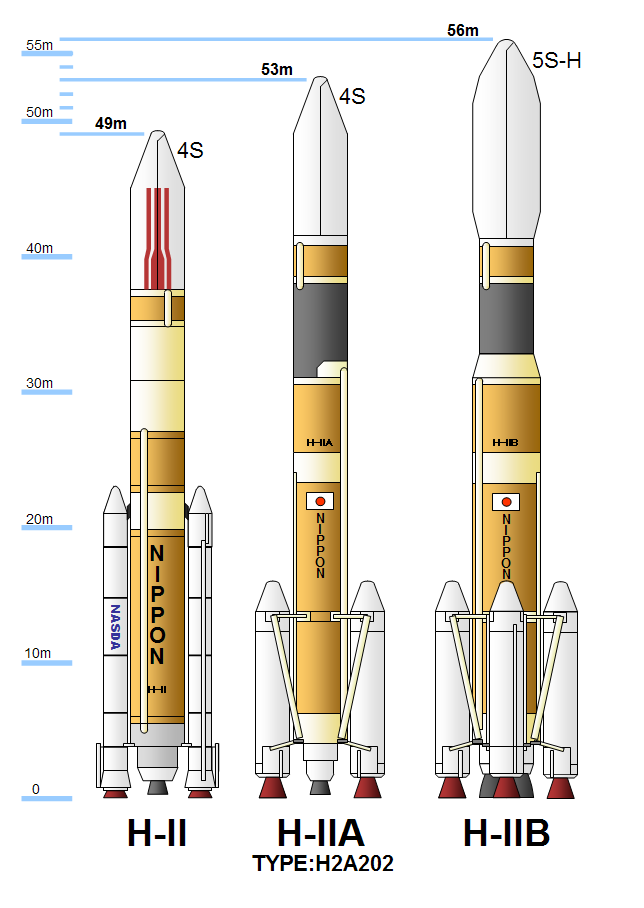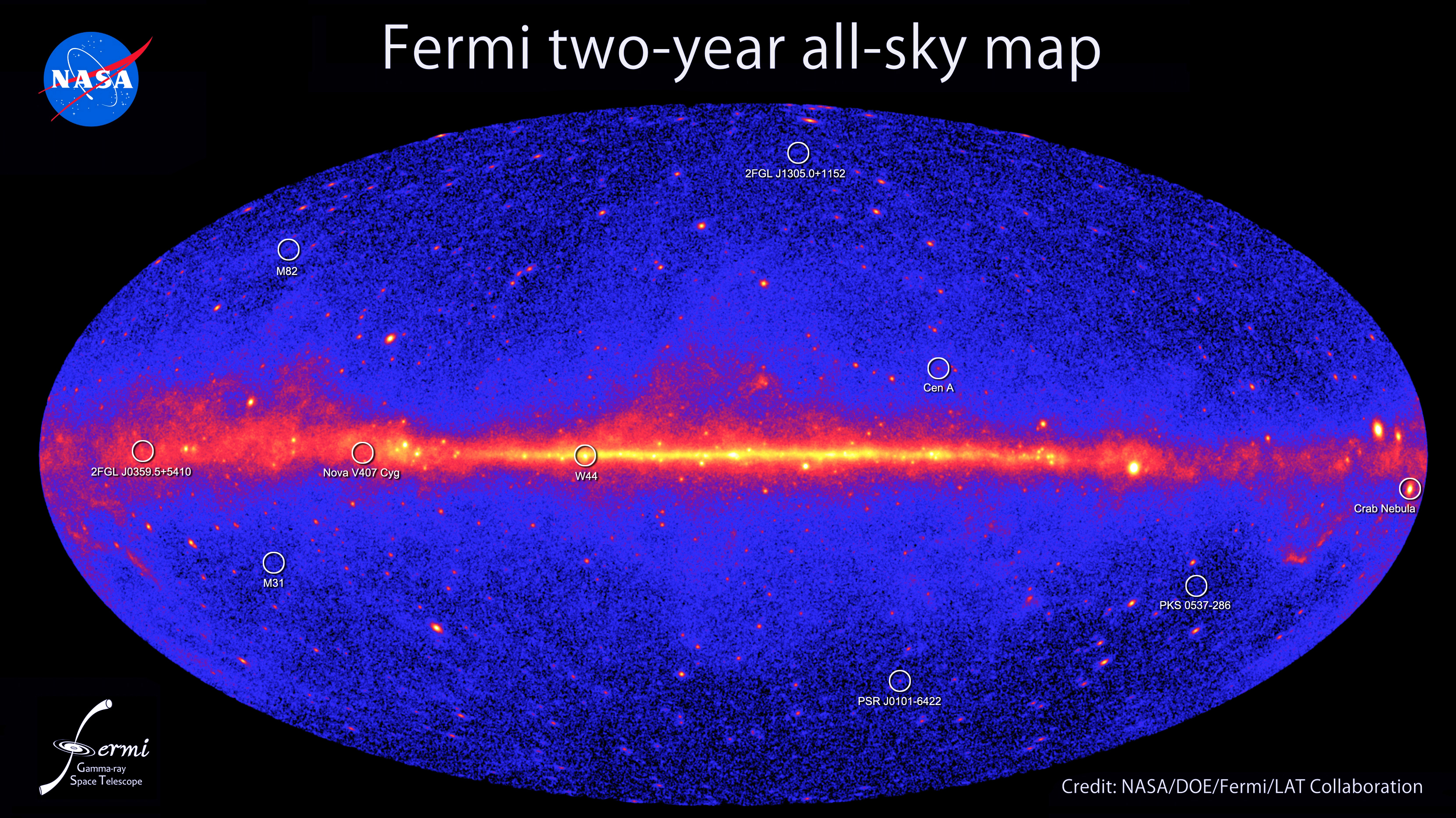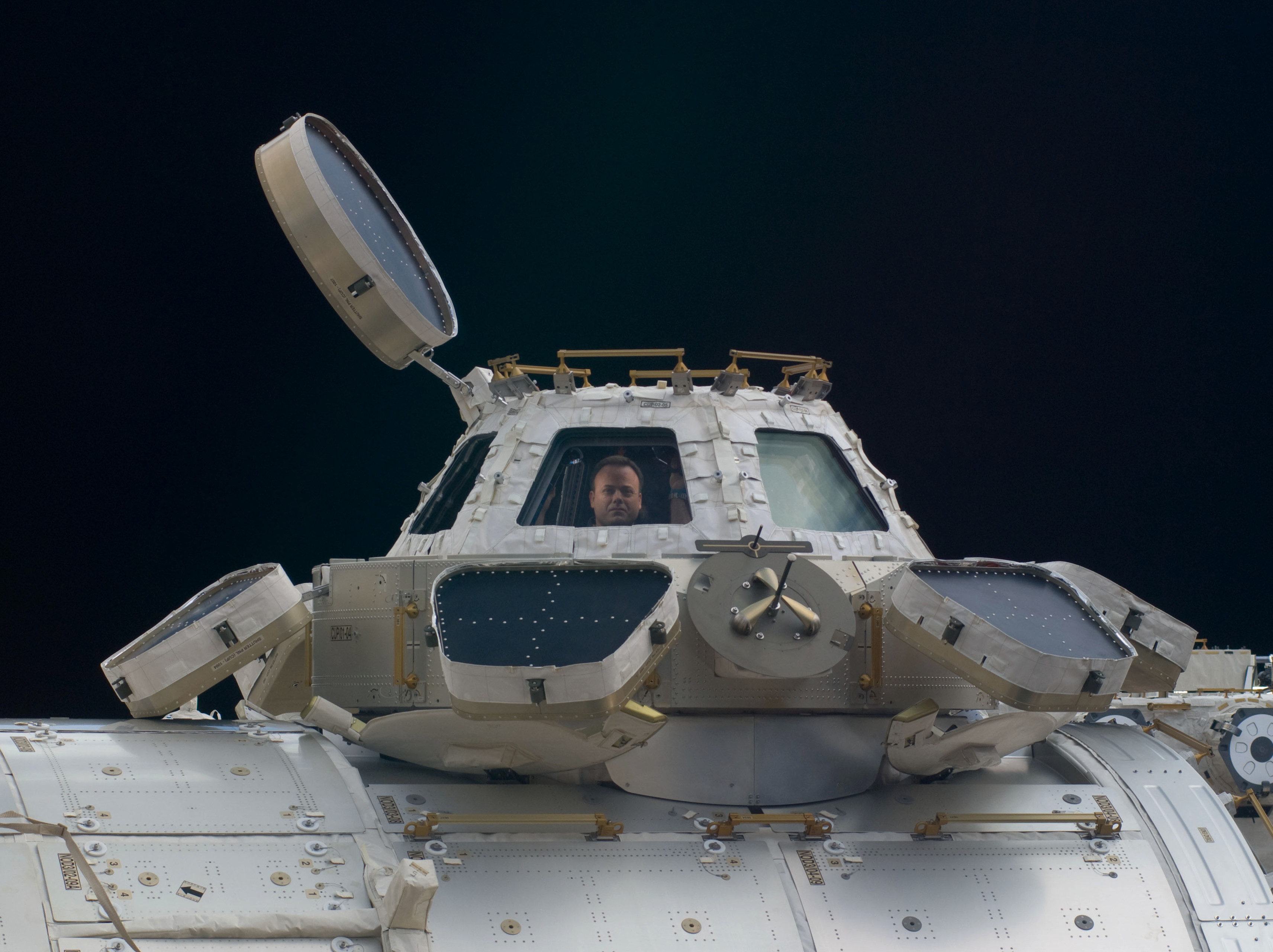|
HTV-5
Kounotori 5, also known as HTV-5, was the fifth flight of the H-II Transfer Vehicle, an uncrewed cargo spacecraft launched to resupply the International Space Station. It was launched on 19 August 2015. Specifications Major changes of Kounotori 5 from previous Kounotori are: * Solar panels were reduced to 49 panels, down from 57 on HTV-1 and Kounotori 2, 56 on Kounotori 3, and 55 on Kounotori 4, since the analysis of the data from previous missions showed that fewer panels were sufficient. A sensor-mount outlet was added since Kounotori 4 at a place previously occupied by a solar panel, and on Kounotori 5 it is used to attach environment measurement equipment (Kounotori Advanced Space Environment Research equipment (KASPER)). * Improvement in the loading of Cargo Transfer Bags allows for increased capacity (maximum 242 CTBs compared to previous 230), and more late access cargo (maximum 92 CTBs compared to previous 80). When approaching the ISS, previous missions were held a ... [...More Info...] [...Related Items...] OR: [Wikipedia] [Google] [Baidu] |
Planet Labs
Planet Labs PBC (formerly Planet Labs, Inc. and Cosmogia, Inc.) is an American public Earth imaging company based in San Francisco, California. Their goal is to image the entirety of the Earth daily to monitor changes and pinpoint trends. The company designs and manufactures Triple-CubeSat miniature satellites called Doves that are then delivered into orbit as secondary payloads on other rocket launch missions. Each ''Dove'' is equipped with a high-powered telescope and camera programmed to capture different swaths of Earth. Each ''Dove'' Earth observation satellite continuously scans Earth, sending data once it passes over a ground station, by means of a frame image sensor. The images gathered by ''Doves'', which can be accessed online and some of which is available under an open data access policy, provide up-to-date information relevant to climate monitoring, crop yield prediction, urban planning, and disaster response. With acquisition of BlackBridge in July 2015, Planet La ... [...More Info...] [...Related Items...] OR: [Wikipedia] [Google] [Baidu] |
H-IIB
H-IIB (H2B) was an expendable space launch system jointly developed by the Japanese government's space agency JAXA and Mitsubishi Heavy Industries. It was used to launch the H-II Transfer Vehicle (HTV, or ''Kōnotori'') cargo spacecraft for the International Space Station. The H-IIB was a liquid-fueled rocket, with solid-fuel strap-on boosters and was launched from the Tanegashima Space Center in southern Japan. H-IIB made its first flight in 2009, and had made a total of nine flights through 2020 with no failures. H-IIB was able to carry a payload of up to to Geostationary transfer orbit (GTO), compared with the payload of 4000-6000 kg for the H-IIA, a predecessor design. Its performance to low Earth orbit (LEO) was sufficient for the H-II Transfer Vehicle (HTV). The first H-IIB was launched in September 2009 and the last H-IIB was launched in May 2020. Development The H-IIB was a space launch vehicle jointly designed, manufactured and operated by JAXA and Mitsub ... [...More Info...] [...Related Items...] OR: [Wikipedia] [Google] [Baidu] |
Calorimetric Electron Telescope
The CALorimetric Electron Telescope (CALET) is a space telescope being mainly used to perform high precision observations of electrons and gamma rays. It tracks the trajectory of electrons, protons, nuclei, and gamma rays and measures their direction, charge and energy, which may help understand the nature of dark matter or nearby sources of high-energy particle acceleration. The mission was developed and sponsored by the Japan Aerospace Exploration Agency (JAXA), involving teams from Japan, Italy, and the United States. CALET was launched aboard JAXA's H-II Transfer Vehicle Kounotori 5 (HTV-5) on 19 August 2015, and was placed on the International Space Station's Japanese Kibo module. Overview CALET is an astrophysics mission that searches for signatures of dark matter and provides the highest energy direct measurements of the cosmic ray electron spectrum in order to observe discrete sources of high-energy particle acceleration in our local region of the galaxy. [...More Info...] [...Related Items...] OR: [Wikipedia] [Google] [Baidu] |
SpaceX CRS-7
SpaceX CRS-7, also known as SpX-7, was a private American Commercial Resupply Service mission to the International Space Station, contracted to NASA, which launched and failed on June 28, 2015. It disintegrated 139 seconds into the flight after launch from Cape Canaveral, just before the first stage was to separate from the second stage. It was the ninth flight for SpaceX's uncrewed Dragon cargo spacecraft and the seventh SpaceX operational mission contracted to NASA under a Commercial Resupply Services contract. The vehicle launched on a Falcon 9 v1.1 launch vehicle. It was the nineteenth overall flight for the Falcon 9 and the fourteenth flight for the substantially upgraded Falcon 9 v1.1. Launch history In January 2015, the launch was tentatively scheduled by NASA for no earlier than June 13, 2015. This was adjusted to June 22, 2015, then moved forward to June 19, 2015, and adjusted again to June 26, 2015. Subsequently, the launch had been rescheduled to June 28, 2015, a ... [...More Info...] [...Related Items...] OR: [Wikipedia] [Google] [Baidu] |
Cupola (ISS Module)
The ''Cupola'' is an ESA-built observatory module of the International Space Station (ISS). Its name derives from the Italian word ', which means " dome". Its seven windows are used to conduct experiments, dockings and observations of Earth. It was launched aboard Space Shuttle ''Endeavour'''s mission STS-130 on 8 February 2010, and attached to the ''Tranquility'' (Node 3) module. With the ''Cupola'' attached, ISS assembly reached 85 percent completion. The ''Cupola'' central window has a diameter of . Overview The ''Cupola'' provides an observation and work area for the ISS crew giving visibility to support the control of the space station remote manipulator system and general external viewing of Earth, celestial objects and visiting vehicles. The Cupola project was started by NASA and Boeing, but canceled due to budget cuts. A barter agreement between NASA and the ESA resulted in the ''Cupola''s development being resumed in 1998 by ESA. The ''Cupola'' is important ... [...More Info...] [...Related Items...] OR: [Wikipedia] [Google] [Baidu] |
Kounotori 3
Kounotori 3 ( ja, こうのとり3号機; English: "white stork" ), also known as HTV-3, was the third flight of the Japanese H-II Transfer Vehicle. It was launched on 21 July 2012 to resupply the International Space Station (ISS) aboard the H-IIB Launch Vehicle No. 3 (H-IIB F3) manufactured by Mitsubishi Heavy Industries (MHI) and JAXA. Kounotori 3 arrived at the ISS on 27 July 2012, and Expedition 32 Flight Engineer and JAXA astronaut Akihiko Hoshide used the International Space Station's Canadarm2 robotic arm to install Kounotori 3, to its docking port on the Earth-facing side (nadir) of the Harmony module at 14:34 UTC. After the supplies are unloaded, Kounotori 3 was loaded with waste material from ISS, including used experiment equipment and used clothes. Then Kounotori 3 was unberthed from the ISS on 11 September 2012 and burned up upon reentering in the atmosphere of Earth on 14 September 2012. Specifications Major changes of Kounotori 3 from previous Kounotori ar ... [...More Info...] [...Related Items...] OR: [Wikipedia] [Google] [Baidu] |
Launch Vehicle
A launch vehicle or carrier rocket is a rocket designed to carry a payload (spacecraft or satellites) from the Earth's surface to outer space. Most launch vehicles operate from a launch pad, launch pads, supported by a missile launch control center, launch control center and systems such as vehicle assembly and fueling. Launch vehicles are engineered with advanced aerodynamics and technologies, which contribute to large operating costs. An orbital spaceflight, orbital launch vehicle must lift its payload at least to the boundary of space, approximately and accelerate it to a horizontal velocity of at least . Suborbital spaceflight, Suborbital vehicles launch their payloads to lower velocity or are launched at elevation angles greater than horizontal. Practical orbital launch vehicles are multistage rockets which use chemical propellants such as Solid-propellant rocket, solid fuel, liquid hydrogen, kerosene, liquid oxygen, or Hypergolic propellants. Launch vehicles are cla ... [...More Info...] [...Related Items...] OR: [Wikipedia] [Google] [Baidu] |
Verification And Validation
Verification and validation (also abbreviated as V&V) are independent procedures that are used together for checking that a product, service, or system meets requirements and specifications and that it fulfills its intended purpose. These are critical components of a quality management system such as ISO 9000. The words "verification" and "validation" are sometimes preceded with "independent", indicating that the verification and validation is to be performed by a disinterested third party. "Independent verification and validation" can be abbreviated as "IV&V". In practice, as quality management terms, the definitions of verification and validation can be inconsistent. Sometimes they are even used interchangeably. However, the PMBOK guide, a standard adopted by the Institute of Electrical and Electronics Engineers (IEEE), defines them as follows in its 4th edition: * "Validation. The assurance that a product, service, or system meets the needs of the customer and other iden ... [...More Info...] [...Related Items...] OR: [Wikipedia] [Google] [Baidu] |
Atmosphere Of Earth
The atmosphere of Earth is the layer of gases, known collectively as air, retained by Earth's gravity that surrounds the planet and forms its planetary atmosphere. The atmosphere of Earth protects life on Earth by creating pressure allowing for liquid water to exist on the Earth's surface, absorbing ultraviolet solar radiation, warming the surface through heat retention (greenhouse effect), and reducing temperature extremes between day and night (the diurnal temperature variation). By mole fraction (i.e., by number of molecules), dry air contains 78.08% nitrogen, 20.95% oxygen, 0.93% argon, 0.04% carbon dioxide, and small amounts of other gases. Air also contains a variable amount of water vapor, on average around 1% at sea level, and 0.4% over the entire atmosphere. Air composition, temperature, and atmospheric pressure vary with altitude. Within the atmosphere, air suitable for use in photosynthesis by terrestrial plants and breathing of terrestrial animals is found only in ... [...More Info...] [...Related Items...] OR: [Wikipedia] [Google] [Baidu] |
Space Test Program
The Space Test Program (STP) is the primary provider of spaceflight for the United States Department of Defense (DoD) space science and technology community. STP is managed by a group within the Advanced Systems and Development Directorate, a directorate of the Space and Missile Systems Center of the United States Space Force. STP provides spaceflight via the International Space Station (ISS), piggybacks, secondary payloads and dedicated launch services. Past activities STP has actually been in existence for 50 years as of 2019, with several thousand launches it has been responsible for. For example, the initial experiments that led to the modern Global Positioning System (GPS) satellite constellation were STP-launched projects. 2001 During August 2001, STP conducted two successful activities using the Space Shuttle and ISS. STS-105 delivered and successfully deployed the Materials International Space Station Experiment (MISSE) externally on the ISS. MISSE was a passive mat ... [...More Info...] [...Related Items...] OR: [Wikipedia] [Google] [Baidu] |
AAUSAT-II
AAUSAT-II (Aalborg University CubeSat no 2), is the second student-built CubeSat built and operated by students from Aalborg University in Denmark. It was launched 28 April 2008 05:53:51 UTC from Satish Dhawan Space Centre in India on a Polar Satellite Launch Vehicle (PSLV) launch vehicle. AAUSAT-II carries a gamma radiation sensor. Educational objective The primary purpose of construction of satellites at the University of Aalborg is to give the students engineering capabilities beyond what is normally achieved within a masters program. History Student satellite activities at Aalborg University (AAU) started in 2003 as a result of AAU's involvement in the first pure Danish research satellite, Ørsted, which was successfully launched in 1999. AAUSAT-II's predecessor was AAU CubeSat which was constructed in the period 2001-2003 and was launched 30 June 2003. The project started in the summer 2003. The construction of AAUSAT-II began in 2005. Operations After the launch ... [...More Info...] [...Related Items...] OR: [Wikipedia] [Google] [Baidu] |


.jpg)



